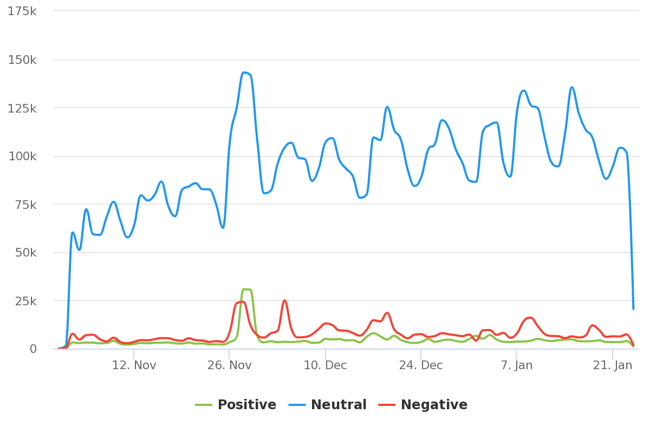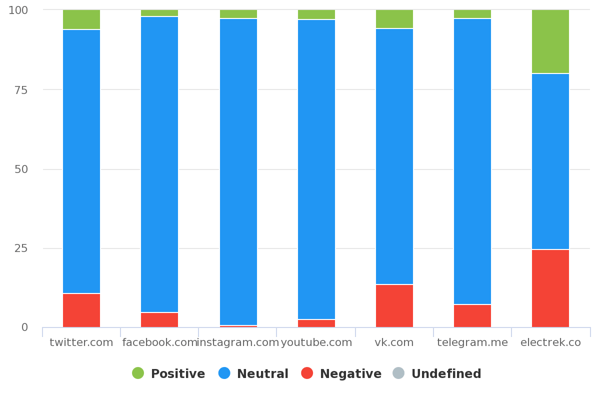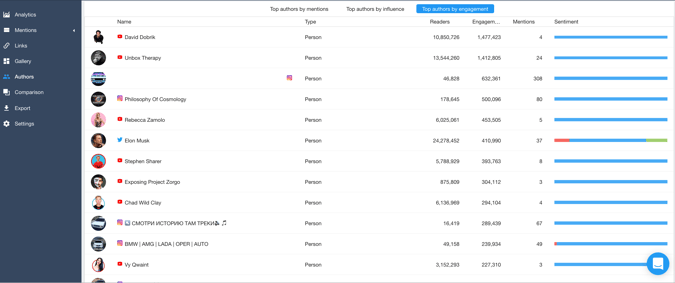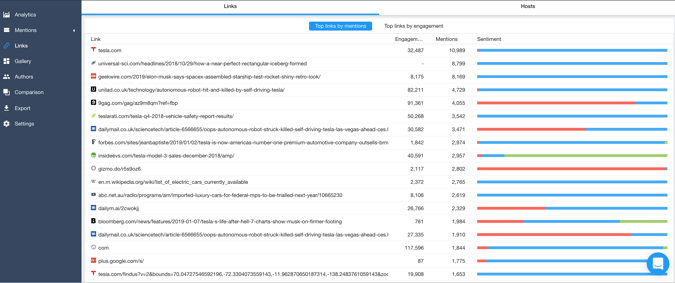February 22, 2019
 by Elena Vinokurtseva / February 22, 2019
by Elena Vinokurtseva / February 22, 2019

If a customer is disappointed with a product or service, what is the likelihood they take their frustrations to social media?
According to our social media statistics roundup, about 42 percent of customers use social media to voice their frustrations. On the contrary, customers are also likely to advocate for brands on social media. This mix of emotions toward brands is what we call sentiment.
Social sentiment is how social media users feel about a particular brand. This sentiment is typically tracked with scraping technologies and interpreted using natural language processing.
Positive, negative, and even neutral sentiment can hold a lot of insight for businesses that consider social media as a key part of its marketing strategy. To study sentiment, we need to understand how it's analyzed and the different ways it's applied.
Sentiment analysis is a fundamental social media monitoring metric that analyzes conversations on social and the web quickly and effectively.
This social listening feature presents an instant overview of all mentions in the monitoring stream, regardless of one's level of experience with analytics software.
Using this function, you can view positive and negative conversation trends, see how the target audience reacted to the latest activation from a competing brand, and connect with buyers.
The graph below shows the basic sentiment of social conversation over time.

Social sentiment isn't so cut and dry, and there are actually a number of ways to both study and measure it.
1. Sentiment in discussions – In the example below, we see the real-time sentiment of discussions pertaining to the topics of alternative energy and electric transport. These real-time reports are called "dynamics," and visually, they're great at detailing high and low points of social sentiment.

2. Sentiment in trends – Going off our example of alternative energy and electric transport, we can use sentiment to also detect potential trends. Mentions containing negative sentiment are marked red, positive-sentiment mentions are green, and neutral mentions are blue. Here, blue highlighted news finds Volkswagen will be spending $800 million in Chattanooga, Tennessee. It will be making Electric Cars.
 3. Sentiment by authors – Social media sentiment can also be filtered by individual authors and accounts. This is useful for identifying brand advocates.
3. Sentiment by authors – Social media sentiment can also be filtered by individual authors and accounts. This is useful for identifying brand advocates.

4. Sentiment in sources and topics – In this example, we analyze sentiment about some recent Tesla updates. This sentiment is filtered by sources and specific topics. This is sometimes referred to as topic affinity analysis, and is great for brands looking to shape future content.

Today's sentiment analysis provides an opportunity not only to assess the sentiment of brand mentions, but also receive a complete range of tools that simplifies communication with target audiences, establishes contacts, shares information, locates influencers, supplies information, and engages in brand promotion.
Social sentiment data can enhance your social media marketing efforts, although, there are a few things to keep in mind when studying sentiment.
Sentiment can only be one of three things: Positive, negative, or neutral. But the impact of each type of sentiment is different.
Remember the rules of human psychology: People are more likely to share something negative than something positive. According to our customer reviews statistics roundup, 82 percent of customers look for negative reviews to influence their opinions.
If you have more negative than positive mentions under the “Analytics” tab of your social media monitoring software, this is not a communication crisis, but rather a working process that you just need to resolve efficiently and quickly.
At a minimum, classify negative messages into categories, determine the types of negativity (constructive, emotional, trolling), draw up a disaster plan (scheme for the transfer of mentions requiring reaction to the appropriate specialists of your company), and develop scenarios (not scripts) of communication with dissatisfied customers.
Negative customer feedback is an opportunity to find out about problems directly – bypassing opinion polls and costly analytical research. In social networks and review platforms, users say everything they think, and that's not always what you want to hear. This is an opportunity to make your products, services, and your business better.
For example, LEGO has long been analyzing its tone of voice and users’ sentiment on social media. This has led to a predominance of positive mentions over negative ones. See below:

1. Consider these figures when it comes to social sentiment. The post author's Facebook friend count, the number of their Twitter and Instagram followers, and the total amount of YouTube subscribers.
These are the first people to see the author's posts, and they're the ones in the author's immediate social circle and sphere of influence.
2. If you found a positive mention about your brand, take a closer look at the publisher's social media following. If the blogger has more than 1,000 followers or subscribers, be thankful for this unsolicited quality promotion and uplift this advocate. But if the same blogger left you a negative review, go back to their first point of interaction and respond immediately.
3. You can dive deeper into analytics and examine whether the source of the mention contains your target audience. For example, the social media groups, forums, discussion boards, etc. where the post was published. If you find a negative comment about a piece of software in a cooking group, it might not affect your reputation too much, but that doesn't mean you should ignore it.
In order to best apply our first two points to your workflow, set up rules for a smart notification that can be sent to you as soon as the mentions are published. This is actually pretty simple to do in most social monitoring tools.
Sentiment analysis is an area of computational linguistics that deals with the selection of emotionally-colored vocabulary or emotional evaluation from texts. Wow, that's a mouthful. Let's break this down in simpler terms.
At the moment, there are two commonly used approaches to sentiment analysis:
Recent developments in artificial intelligence (AI) have improved its methods of automatic sentiment detection, but AI still falls short when it comes to identifying the sentiment specifically as it pertains to the main subject of the mention. The same words can carry negative or positive connotations in different contexts.
For example, "Dawn is great for washing dirty dishes," is a positive mention, while, "Coca-Cola is great for washing dirty dishes," is a negative comment about the beverage. This is simply because Coca-Cola isn't interested in being associated with a household cleaning product.
 Advanced monitoring software works with an object-oriented model that uses the latest developments in big data and deep neural networks.
Advanced monitoring software works with an object-oriented model that uses the latest developments in big data and deep neural networks.
Training these models requires a dataset of more than 2 million marked-up mentions from a variety of fields – such as taxi services, online retail, finance, pharmacology, news media, politics, sports, food and beverage services, consumer goods, and more.
By constantly training the algorithm, data scientists are able to achieve the accuracy of up to 90 percent in identification of positive and negative sentiment. In marked-up topics that contain a large data set of mentions with correctly assigned sentiment, that accuracy increases to over 95 percent.
At the heart of the model are deep neural networks with recurring memory layers, as well as layers that identify which part of the post needs to be analyzed based on the context, subject, and topic.
Thanks to a large training data set, developers are able to teach this model to understand the specifics of social media communication in order to accurately determine sentiment for different brands according to their unique demands.
With the solid foundation of a marked-up dataset, even tricky cases like the Coca-Cola example don't pose a problem – the model will "understand" the context.
It's impossible to detect sentiment in posts without any copy. While image recognition and text mining tools can spot a logo in a wordless social media post, the context in which the logo appears can only be detected by manually viewing the photo or using Visual Insights – a graph of objects and settings that most frequently appear with a brand's logo.
 It's also important to remember that sometimes, users don't provide copy or context and simply post a picture. This will affect the accuracy of sentiment analysis.
It's also important to remember that sometimes, users don't provide copy or context and simply post a picture. This will affect the accuracy of sentiment analysis.
Nevertheless, technology is constantly improving, and the future of monitoring systems is to recognize the sentiment not only of the texts of users' messages, but audio and video.
Massive data science teams will likely solve these problems by teaching machines to understand all the intricacies of human speech in a not-so-distant future.
Ready to understand your social audience in greater depth? Check out our complete guide to social media analytics and how marketers can be more data-driven.
Elena is the Head of PR and Content at YouScan. At G2 Crowd she writes about social media listening, digital marketing, data, analytics and customer experience. Prior to YouScan, Elena provided PR to initiatives on the development of digital education, and also led a digital project in the field of cloud computing. In her free time she enjoys board games of all sorts in friends company
Logo recognition is related to object detection, a computer technology linked to computer...
 by Elena Vinokurtseva
by Elena Vinokurtseva
Are you a marketer looking for more ways to capture and analyze the many ways users interact...
 by Devin Pickell
by Devin Pickell
Image optimization is an important step to achieving a better ranking, no less important than...
 by Angela Ash
by Angela Ash
Logo recognition is related to object detection, a computer technology linked to computer...
 by Elena Vinokurtseva
by Elena Vinokurtseva
Are you a marketer looking for more ways to capture and analyze the many ways users interact...
 by Devin Pickell
by Devin Pickell

